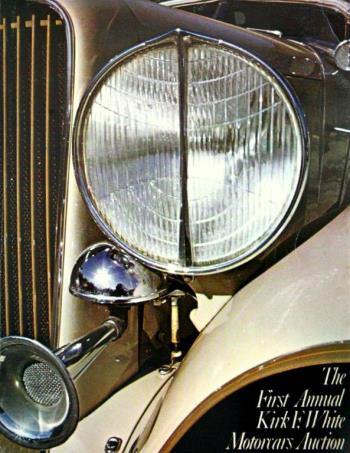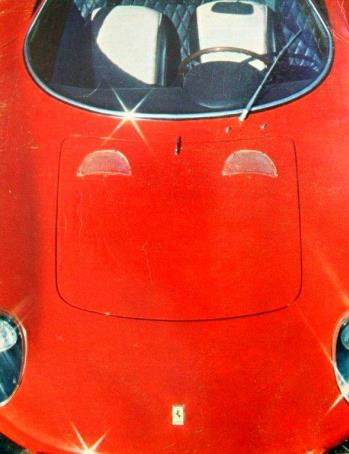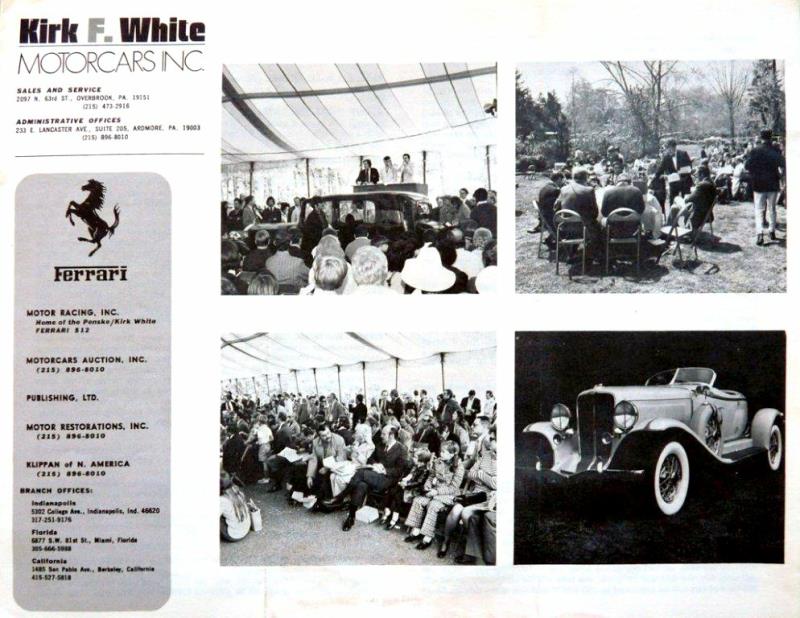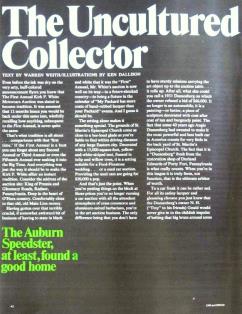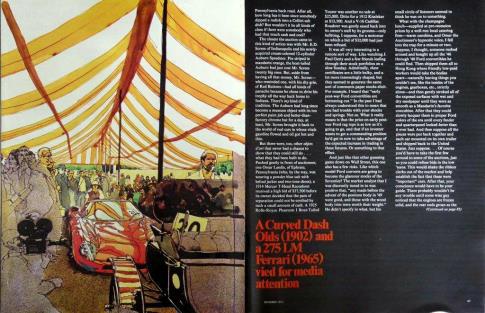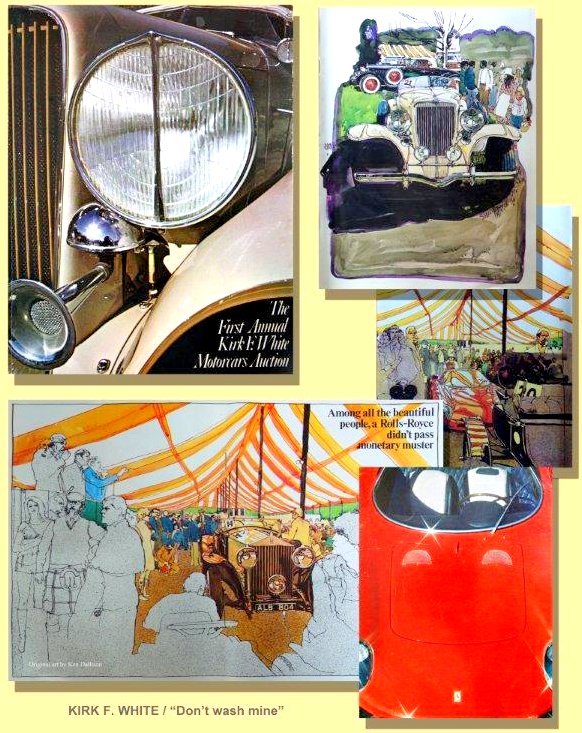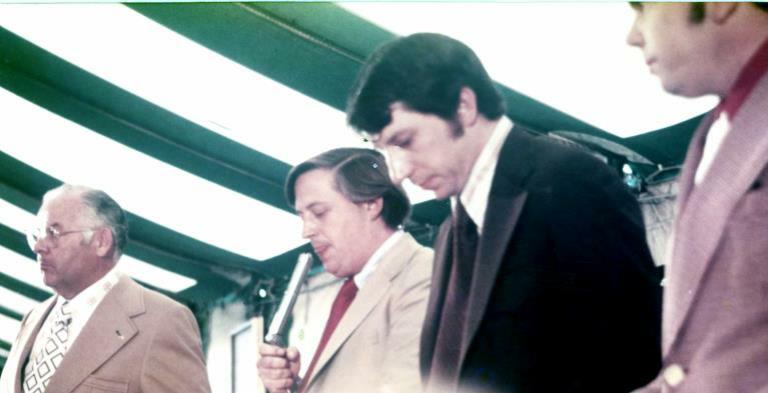554
We came home from Sebring and it was high time that we got back to the business of buying and selling “real” European automobiles!
Plus, we had our Classic car auction coming up Saturday, May, 1 . . .
(. . . Classic car auction? Really Kirk?
Just when were you planning on telling everyone about this hare-brained scheme . . .)
With all the Ferrari 512 building, testing, and racing that transpired in 1970 into early 1971, there didn’t seem to be a proper opportunity to pass along an idea that I came up with in the late fall of 1970.
SO, HERE’S HOW IT ALL CAME ABOUT. . .
On a blustery early spring afternoon in 1970, I was in Manhattan on other business. When I’d finished my appointment, I headed to Sotheby’s Auction Gallery on east 72nd Street.
A small ad had surfaced in the New York Times stating that Sotheby’s would be auctioning some older Rolls Royce and Bentley automobiles, along with a handful of other prewar “classics.” I decided I’d swing by the gallery to have a look at the cars.
I was not aware that the sale itself would be underway that very afternoon.
Chapter 18
555
As I turned on to 72nd Street, I could see there was some bit of activity underway in front of Sotheby’s. There was not enough of a crowd to really disturb the flow of traffic. As I got closer to the gallery, I could see an elderly behemoth of a Hooper bodied Rolls Royce Silver Wraith limousine, with its two driver’s side wheels up on the sidewalk, and the nearside wheels in the street!
The scene, as I drove by slowly, was nearly amusing.
Being gifted with an overly active imagination I allowed the following scenario to develop in my mind.
In my mental skit, it appeared to me as if the great lumbering Rolls Royce that was being auctioned may well have been drunkenly lurched half on to the sidewalk by an inebriated chauffer.
One could almost conjure an image of the Police having been summoned, the besotted chauffer being hauled off to the pokey, and the poor old Rolls being auctioned off on the spot!
A slightly leaning tall podium on wheels was perched near the Rolls.
I parked easily less than a block away and went back to have a look. The Wraith had been replaced by another equally ponderous giant of a Rolls limousine, again being offered at the same drunken tilt.
As additional cars were called for, they were emerging from an underground garage, a half block up on 72nd Street.
Edging myself close to the cars on the “block” and listening carefully, I was able to faintly hear the auctioneer gently imploring the small gathering to offer a bid on this dusty, old dowager.
You could not help being struck by the lethargic nature of the event.
556
The auctioneer was moving the sale along at a funereal pace from his wheeled perch. He would very gently request a bid from his meager audience and when he received a bid he would quietly thank said bidder, then slowly peer out at his scant audience, quietly urging anyone for an advance on the bid just given.
It was a very, very, slow proceeding.
That particular auctioneer would have been perfect for a sale of Victorian ladies hankies in the tea room of the Savoy, in London.
Trying to sell giant, tired, old Rolls Royce’s and Bentleys outdoors in the chilly, bustling canyons of the east seventies in Manhattan was tough enough, but then to have your merchandise sitting cockeyed, half in the street, and half on the sidewalk was simply bizarre.
I watched two or three of the cars being slowly sold, and then walked up to the entrance to the underground garage where the cars were emerging. I turned to go down into the garage to have a look at the upcoming selection, but was told sharply that no one was allowed down there.
I’d have to wait for each vehicle to emerge and commence any due diligence from the street as the car slowly advanced the few yards to the auction block.
The event bore a hopelessly heavy atmosphere and I left shortly thereafter.
THE TINIEST SPARK OF AN IDEA . . .
Driving back to Philadelphia late that afternoon, I began to sort through what I’d seen. All of my above wise-apple remarks notwithstanding, I was fascinated by the idea of auctioning antique and classic cars.
Sotheby’s had stepped forward and done it, hadn’t they?
And, by no means was this the first time that antique and/or classic automobiles had been sold by the auction process, yet almost never were automobiles the sole auction attraction.
557
But, I couldn’t get that whole afternoon on 72nd Street out of my head. I was sure I’d seen a spark of something that somehow might lead to a more exciting, attractive way of running an event like that.
I wanted to talk with my friend “Tiny” Gould about the idea.
Kirk F. White Motorcars had, of course, been fortunate to have established a recent alliance with M.H. “Tiny” Gould.
Gould was one of the two or three top classic car dealers in the world. Our July, 1970, “Kirk F. White Newsletter” introduced our readers to Tiny’s amazing establishment in Trucksville, Pennsylvania, near Wilkes Barre, Pennsylvania.
In becoming allied with our fledgling company at that time, Tiny was an incredible asset for us, which I expect is another way of saying that Tiny was a “landed” businessman, where I had to be roped back into the corral more than a few times!
At least twice a month I would travel to Trucksville, Pennsylvania to have dinner with Tiny. There was a great deal to learn from him.
In the middle of the third week following the Sotheby’s auction, my mind was still all over developing an auction concept; so, I guess I was at least going to put it out there.
I called Tiny, and a day or two later we got together. I went over with him every detail of the drab, slow moving event that had taken place in New York that afternoon.
There simply had to be a way to knock together a more exciting and effective antique and classic car auction.
Both of us had attended the high powered, rapidly paced dealer auctions in Manheim, Pennsylvania. The dealer auctions represented the other extreme of automotive auctioneering. The Manheim facility had multiple auction lanes in a large dedicated building with rapid fire auctioneers who rivaled the best of the tobacco boys in the south.
558
Manheim was the king of the established wholesale auto auctions, and Bordentown, in New Jersey was another mighty strong sale. Those sales were high volume venues for dealers who came from all through the eastern United States.
Tiny had attended Henry Austin Clark’s museum dispersal auction in 1963! Clark’s sale had been a rather “clubby” affair, but in spite of it was quietly effective.
Tiny said he thought my loosely gathered ideas were viable. The prospect of putting together a top notch auction at an appealing location, offering only top antique and classic automobiles, along with crack auctioneers appeared to be an attractive combination.
“Let’s meet in Ephrata next week for dinner; there’s someone I’d like you to meet,” Tiny said.
The following week Tiny introduced me to a gentleman named Omar Landis. Omar owned and ran a successful wholesale automobile auction in Ephrata, Pennsylvania within a few miles of that mother ship of all dealer sales, Manheim. Manheim ran each Friday, and Omar’s “Garden Spot Auto Auction” ran each Tuesday, at 10 AM, sharp.
We all met at a small restaurant in Ephrata, Pennsylvania the following week. Tiny and Omar Landis were there when I arrived. Tiny introduced us.
Omar rose to say hello. He was well over six feet tall, with a thick head of black hair; he had a reserved, but very pleasant demeanor.
He was serious by nature, but gifted with a remarkable sense of humor, and a brilliant smile when the occasion called for it. His voice can best be described as “commanding.” Not loud or brash, it was just a voice you turned to listen to.
I liked him straight off.
We spent a very productive evening. Omar was clearly enthused by the prospect of our idea, and he offered some very salient points.
559
The following Tuesday, I took a ride out to Garden Spot Auto Auction to watch Omar’s sale. It was truly located in a “Garden Spot,” as it was literally in the midst of the Lancaster County farm lands!
Modest, yet very successful, Omar’s auction facility ran like a well oiled machine.
When I arrived there, the sale had just started and Landis was on the block.
I had never seen an auctioneer sell the way Omar did. He was magical. I just sat there transfixed. He had complete control of the room. He made each bidder feel as if he was the shrewdest buyer in the house, and then he’d switch his admiration to the next bidder, and then back to you. I couldn’t get enough of watching him. He wove in a remarkable sense of humor with his selling.
Hell, I wasn’t the only one who was mesmerized; virtually everyone in the room was captured by the Omar’s ‘stitching and gathering’ auctioneering.
Two brothers, Jerry and Tom Girvin worked the other two lanes. Each in his own way was a crackerjack auctioneer.
* *
* *
* *
* *
* *
* *
* *
* *
* *
*
Some few years back, I had a chance to watch Omar Landis’ grown up, but still young, Jim Landis, selling on a slow moving, late Thursday evening at one of the Scottsdale Barrett-Jackson televised extravaganzas. Jim definitely had Omar’s charisma and command.
Jim was selling a car that had stalled at what any sane man would have thought was plenty of money, but Jimmy got another bid, and then another. He had the bids way up there, when a “ring man” ran the car “off the money.” That bidder said he hadn’t really bid!
560
The auction went into a death pause, as everyone involved seemed to come out of the ether simultaneously. The bidding had risen into the low eighty thousands on a car that should have sold for half that, when the balloon had burst.
Landis calmly had to march all the way back to the low fifties to reignite the bidding. Laboriously, but steadily he brought the bidding, incredibly, back into the eighties for a second time, finally sending the car away, sold at $88,000!
It was impressive, and I saw a lot of his Dad in that slice of work . . .
* *
* *
* *
* *
* *
* *
* *
* *
*
NARY A WORD . . .
I remember thinking that I really should get back to selling cars, and cut out the nonsense with this crazy auction idea.
I hadn’t the foggiest idea where to even start to put such a scheme together.
Then one brilliant Spring Sunday morning, I came out of St. Martin’s church in Radnor, Pennsylvania with my family. St. Martins was our neighborhood parish. It was situated in Radnor, on a magnificent pastoral campus, smack in the midst of Philadelphia’ fashionable main line.
That morning everyone in the congregation was commenting and enjoying the glorious blooming Dogwoods.
I gave the Dogwoods a cursory glance, but then I gazed out over the large parking lot, which was in the middle of that lush landscape, noting it had well planned entrances at both ends.
561
There it was! I was looking at it! St.Martins was the perfect place to hold an antique and classic car auction!
So, while the rest of the congregation admired the lush blooming church landscape, my mind was driving tent stakes into the macadam of the parking lot, picturing how many oily old cars we could squeeze on to the grounds, and where to put the bleachers!
While the children were being retrieved from Sunday school, I was already mentally raising a brilliant, large, yellow and white tent covering a good deal of the well paved parking area. There would be low rising bleachers a good many chairs, a champagne box lunch, and a solid number of great automobiles to be offered for auction.
Okay, so as of that Sunday Morning I had a great piece of real estate. Never mind that I hadn’t said a word to Dr. Jeffreys, the minister of St. Martins, about actually allowing us to hold the event there!
In the September, 1970 Newsletter, I had announced the formation of Kirk F. White Motorcars Auction, Inc. and the fact that in the spring of 1971 we were expecting to stage:
“. . . The largest and finest classic car auction ever to be held. The entire affair will be run in a thoroughly professional manner. We are most anxious to establish this annual event as the best of its kind in America.” I wrote.
(. . . Good heavens, where did I come up with this stuff?? I can’t imagine how a good deal of it withstood the cold light of day at the time.)
I then went on to urge people to contact me if they were interested in disposing of either an exceptional automobile or what I referred to as “automobiliana.”
In the November, 1970 Newsletter I posted another epistle advising our readers that over 600 people (??!!) had responded to the “auction” and that we were getting all the various contracts, paperwork, etc. together.
562
Landis, White and Gould had drawn the line at 100 automobiles. The Newsletter stated that we’d received 187 selling inquiries, which meant we probably had a good solid 87 in hand, very few of which would qualify as “absolutely stunning” for “the finest field of cars ever gathered for auction.”
(. . . Occasionally, it seemed that a dram or two of J&B may have taken over the wheel of my literary bus during late evening bits of writing copy . . .)
Early on, we did receive consignment offers of some really off the wall cars, many of which were “mow arounds” in peoples yards, Aunt Nellie’s rusted out old ’40 Plymouth coupe that had been next to cousin Ned’s barn for lo these many years, etc. etc.
We just weren’t getting the birdcage Maseratis, and C-Type Jaguars, Ferraris or supercharged Bentleys at that point.
We sharpened the edges of our request material, and things got a bit better.
By the time we got to February we were setting a deadline of March 1 for entries. In the Newsletter I wasted a lot of wind and type telling one and all that the first 100 catalogs would be numbered (!) Number 1 was to be sold at $100 (!) (Someone actually did buy it!)
Number 002 was to be: “retained by the company” . . . and the remaining 98 sold for $25 each. The balance of the catalogs would be available at $4.50 plus $1.00 for postage!
Such arrogance!
Our April 1971 Newsletter told the readers that the catalog would be mailed April 8 (Yeah, we missed the deadline, but not too badly.) We re-emphasized that everyone who attended would enjoy champagne and a “superb luncheon.”
We listed a 1907 Benz, a 1910 Hispano Suiza, 1914 Mercer, three quite good Bugattis, four Packard’s, a Du Pont Phaeton, two supercharged Alfa Romeos, Nine Rolls Royce’s, two Auburn Speedsters, 2 Duesenbergs, 12 Ferraris (!), four Jaguars, and a good many more additional automobiles. Our consignment at that point was on the high side of sixty!
563
The consignments continued to roll in and the cars were pretty darn good.
We ran advertisements in every remotely applicable venue. We placed substantial “stand alone” ads in the New York Times!
I was just beginning to feel like it might hook up and come out of the gate running!
THEN, AN UNHOLY HELL STRIKES!!
The week before the sale, our 63rd Street garage was packed with cars that had been sent in early for the auction. The Tuesday night before the May first Saturday of the auction, a pack of thugs broke into 63rd Street and slung gallons of paint all over the place.
No, I’m not kidding! I must have had to say that I wasn’t kidding 100 times the following morning, gathering together every soul we knew to do what we could, as fast as we could.
All manner of kudos went out to Mike Tillson and his guys. Molin Body Shop literally closed their doors and came to help us through the nightmare.
Miraculously we were able to get every bit of the damage handled, save one small edge of one fender where we had to announce the slight damage from the auction block.
The tents went up on Thursday, the bleachers came in, it really all came together quite well.
564
AUCTION DAY, MAY 1, 1971
May 1, 1971 dawned crystal clear. It was the most dazzling May first in the history of the world. The weather was absolutely perfect.
I’ll let my account from our Newsletter the following month pretty much tell it as it happened.
* *
* *
* *
* *
* *
* *
* *
* *
* *
* *
*
KIRK F. WHITE, MAY 1971 NEWSLETTER:
“KIRK F. WHITE MOTORCARS AUCTION, MAY 1 – After all our months of hard work, it’s over. I enjoyed the auction so much, that I wanted to do it all over again the next day. I don’t expect Ed Casey, our General Manager shared that idea with me.
Ed was the man who shaped the auction from a series of ideas into a working, functioning event with Saturday, May 1 as the culmination point. It is impossible to conceive of the effort and details necessary to piece together an event like this. Tents, food, liquor, catalog deadlines, printing, forms, phones and on and on.
The March weekend of Sebring, where we had gone to run the Ferrari, Ed stayed home to piece together the catalog. We owe him the greatest vote of thanks for an outstanding job.
We fielded the largest and most representative group of automobiles ever put up for auction sale. Many who attended told me that they had never seen so many splendid automobiles.
For this we thank the many who placed their fine cars in the auction particularly Tiny Gould, Herb Wetson, Dr. Erle Heath, Robert Marceca, Marvin Newman, Tom Lester, in fact everyone involved.
In addition to the cars themselves, our biggest asset was Omar Landis, our auctioneer. I know of people who came to the auction just to hear him work. The crowd was worth watching as the first few cars went through. Many just sat there with mouths half open. Then they realized this man and the whole scene was the greatest thing since night baseball and the sale was off and running.
Old timers and newcomers alike said they’d never watched and listened to an auctioneer like Omar in their life. We are going to sign him to a lifetime contract so that in future events you’ll be assured of having the finest man in the business handling our sales.
One last point was the fact that we were the first auction to announce “No Sales”. The first few stunned the crowd as previous auctions, such as the affair I’d attended in New York always fluffed over the unsold vehicles and indicated their entire field had been sold which was confusing and misleading. Our audience enjoyed getting the facts straight right off the bat.
We learned a lot and have just finished a long meeting to smooth out and set up the 1972 event. We had some beautiful mistakes this year (such as no page numbers in the catalog,) an almost impossible system of establishing Lot #’s, no cigarettes, not enough press facilities, way too many lunches, way too many catalogs, etc.
Security was a bit weak with over 1000 people finding their way in without paying. Funny stories of the day included the guy who arrived at the lower driveway, set up a card table and began hawking his own tickets. Heaven knows how long he was there before he was discovered and made off into the bushes.
Then we had KFW, stepping down off the auction podium for the NBC TV cameras, with Barbara Walters! White issuing profound words for the world at large while one of Motorcars own 275 LM’s got knocked down for $2,300 less than the money we had in it!
Anyway we are working out the kinks and in 1972 the paperwork will roll smoothly, the tent will be larger, the lane will be completely sealed off, the field of cars will be expanded to 150 and in addition to the sale on Saturday, we will have a champagne preview Friday afternoon and evening. The dates will be:  APRIL 28, 29, 1972”
APRIL 28, 29, 1972”
565
566
* *
* *
*  *
* *
* *
* *
* *
* *
* *
* *
*
The world in early 1971 must have been ready for classic car auctions. We received incredible press coverage. All the major network affiliates gave us extensive air time from the AP, UPI, truly all of the wire services, Business Week magazine, all three major networks, Playboy, and of all things, Women’s Wear Daily!
But, the big excitement was the great sports writer, Robert Jones of “Sports Illustrated” who gave us six pages of coverage in SI!
Ken Dallison rendered fantastic artwork for Car and Driver’s extensive article, which was authored by the legendary Warren Weith!
And on and on . . .
A gentleman from Indiana had paid a staggering $20,000 in cash for our Catalog cover automobile, a wonderful Auburn Speedster and proceeded to drive it back to his home in Indiana with a local Indiana radio station tracking him all the way. And that wonderful event triggered an AP “Special Interest” wire story that seemed to appear on the front page of every newspaper in America!
Simpler times . . .
Who’d have guessed? . .
BARBARA WALTERS & “THE TODAY SHOW
Mid Auction, a man who was involved with our company came over to the block and motioned for my attention. I indicated that it was not a good time for me to chat. He persisted.
“Not right now,” I said
567
“Barbara Walters is here and she wants to interview you about the auction.”
At that point the sale was moving at a good cadence. Omar and I were really working well and smoothly with one another. I was doing the descriptions of the cars and past that, if the bidding stalled, I would step in and remind everyone what an incredible opportunity they were missing right there in Radnor, Pennsylvania!
Straight from the start Omar and I had meshed together well.
“Who is Barbara Walters?” I asked, indicating: “Can’t this wait till the damn auction is over??”
“She’s with the “Today Show,” he said.
Get this: I didn’t know what the hell the “Today Show” was!
At that point I turned behind me to see this well dressed, attractive lady with an ample crew and cameras in tow.
I looked at Stanley; he wasn’t going away until I came down off the block to talk with this Barbara Walters.
She was a lovely lady and as delightful as she could be, right up to the point when the cameras and lights lit up and she tried to sucker punch me a couple of times with cleverly loaded questions.
Nothing sinister, more along the lines of did we really know what the hell we were doing there today? And, was I disappointed with the way the sale was going in any way, because we were announcing “no sales”? She thought there had been more than a few.
Of course, at the very moment as she asked that question, and as I answered her with a bright, cheery face, how swimmingly it was going, our company owned Ferrari 275 LM was crossing the block and being sold for $2,300 less than our cost in the car!
568
PURCHASING MY WAY TO HEAVEN
The arrangement we had with the St. Martins church was that we would donate all the gate proceeds to the church. The next morning Dr. Jeffreys announced to the parishioners that we had given over $10,000 to St. Martins. He further told them that the church was in dire need of those funds and what a blessing it was!
(I hope that “item” is still on my sparse list if I get to the gates . . .)
The operation of the auction had been pretty loose around the seams with easily a thousand people wandering in without paying. We ended up providing local charities with our left over wonderful box lunches, and God knows how much champagne we were forced to consume following the sale!
We made a small amount of money, but the ensuing publicity all over the country was astonishing.
In the same newsletter following the auction, I was still trying to flog those damn catalogs, now with a price key and at a dollar less!
A FINAL ASIDE . . .
The following year, 1972, Omar, Jerry Girvin and I had stepped up on the auction block and were just about to fire off the second annual auction. I was going over some last minute notes with Omar. I looked up and four gentlemen in tan suits with tan felt Stetsons were sitting in the first row directly in front of the auction block.
L. to R. "'Tiny" Gould, KFW, Jerry Girvin, Omar Landis, 1972"
“Omar, do you have any idea who those characters are?” I asked.
569
“They’re the Kruse Brothers from Indiana. They’re big farm and land auctioneers out in Auburn.” He said.
After the sale they introduced themselves. They said they thought we’d run a real fine sale and they might try something like that out there in Indiana that Fall of 1972 . . .
CLEARING UP AN INCIDENTAL . . .
So, this may be a good opportunity to clear up who started these colorful high visibility auctions.
Today, several auction companies indicate that they are the very first, finest and oldest classic car auctioneers in America. And a few are prone to “backing” their inception date up from time to time . . .
Some seemingly indicating they’d been running their extravaganzas since the close of the Korean conflict!
Just to square it up, that May 1971 event was the sale that launched the Antique & Classic car auctions that we know today.
Chapter 19
Coming November 15
. . . The Rest of The Le Mans Adventure . . .


